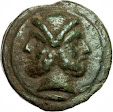If bronze ingots were used for money, how were they measured. It seems likely that steelyard scales would have been used. They are better for weighing heavy items than the double balance scale.
The following pics are from my display at the Texas Numismatic Association (TNA) meeting in June.
The display shows one week's pay in the large pan of the steelyard scale = 21 Asses = 6900 grams = 15 US pounds. Rome did not produce coins in 400 BC. The pan includes some cast bars, cast cakes and Aes Rude pieces.
Pages of plates from Haeberline, see pic and info on the book below, cover the bottom of the display are. Some pieces not needed to make 15 pounds of bronze are shown.
This double pan balance holds half a day's pay or 1.5 Asses. The scale weights in the left pan weigh one As and one Semis (= S = VI VNCIA = 6 Roman ounces).
Haeberline's book and plates.
Hab plate 21. This must be a blue state set of Aes Grave, the prows are pointing left and they weigh less. Prows pointing right weigh more.
Roman scale weights, the left one is 6 ounces and could be Republican, the right one has a portrait that looks like a LRB (late Roman Bronze, or 3rd centruy AD) to me.
I bought this Roman Steelyard scale as a lot of two pieces. The weight has a portrait that looks like LRB. The balance arm could be older or newer.
Several weights that could be used with a steelyard scale. I have the one in the lower right on the balance in the picture, but the scale is held by a second hanger to keep from having problems in the case.
I tested my scale using windshield washer fluid before building the display.
A few more pics for good measure:
http://www.vroma.org/images/raia_images/factory_utensils.jpg
The above pic from a Sands of Time email.
another Haberline plate showing a Ramo Secco bar















No comments:
Post a Comment